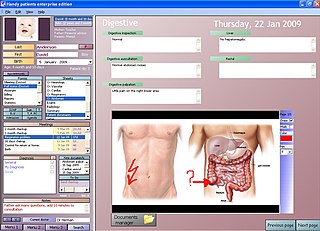
Health informatics is the study and implementation of computer structures and algorithms to improve communication, understanding, and management of medical information. It can be viewed as a branch of engineering and applied science.

An electronic health record (EHR) is the systematized collection of patient and population electronically stored health information in a digital format. These records can be shared across different health care settings. Records are shared through network-connected, enterprise-wide information systems or other information networks and exchanges. EHRs may include a range of data, including demographics, medical history, medication and allergies, immunization status, laboratory test results, radiology images, vital signs, personal statistics like age and weight, and billing information.
The Vanderbilt University Medical Center (VUMC) is a medical provider with multiple hospitals in Nashville, Tennessee, as well as clinics and facilities throughout Middle Tennessee. VUMC is an independent non-profit organization, but maintains academic affiliations with Vanderbilt University. As of 2023, the health system had more than 3 million patient visits a year, a workforce of 40,000, and 1,741 licensed hospital beds.
Health information exchange (HIE) is the mobilization of health care information electronically across organizations within a region, community or hospital system. Participants in data exchange are called in the aggregate Health Information Networks (HIN). In practice, the term HIE may also refer to the health information organization (HIO) that facilitates the exchange.

The College of Healthcare Information Management Executives (CHIME) is a professional organization for chief information officers and other senior healthcare IT leaders. CHIME allows for healthcare and medical executives to collaborate, develop professionally, and advocate the effective use of information management to improve the health and healthcare internationally.
A Regional Health Information Organization, also called a Health Information Exchange Organization, is a multistakeholder organization created to facilitate a health information exchange (HIE) – the transfer of healthcare information electronically across organizations – among stakeholders of that region's healthcare system. The ultimate objective is to improve the safety, quality, and efficiency of healthcare as well as access to healthcare through the efficient application of health information technology. RHIOs are also intended to support secondary use of clinical data for research as well as institution/provider quality assessment and improvement. RHIO stakeholders include smaller clinics, hospitals, medical societies, major employers and payers.
In 2004, the Agency for Healthcare Research and Quality of the United States Department of Health and Human Services created the AHRQ National Resource Center for Health Information Technology to support over 125 federal grants and contracts that are demonstrating the value and implementation of information technology in health care.
An integrated delivery system (IDS), also known as integrated delivery network (IDN), is a health system with a goal of logical integration of the delivery (provision) of health care as opposed to a fragmented system or a disorganized lack of system.
The emerging field of Health administration informatics is concerned with the evaluation, acquisition, implementation and day-to-day operation of information technology systems in support of all administration and clinical functions within the health care industry. The closely related field of biomedical informatics is primarily focused on the use of information systems for acquisition and application of patients' medical data, whereas nursing informatics deals with the delivery, administration and evaluation of patient care and disease prevention. What remains unclear, however, is how this emerging discipline should relate to the myriad of previously existing sub specializations within the broad umbrella of health informatics - including clinical informatics, bioinformatics and healthcare management informatics - particularly in light of the proposed "fundamental theorem" of biomedical informatics posed by Friedman in early 2009.
Health information technology (HIT) is health technology, particularly information technology, applied to health and health care. It supports health information management across computerized systems and the secure exchange of health information between consumers, providers, payers, and quality monitors. Based on a 2008 report on a small series of studies conducted at four sites that provide ambulatory care – three U.S. medical centers and one in the Netherlands, the use of electronic health records (EHRs) was viewed as the most promising tool for improving the overall quality, safety and efficiency of the health delivery system.
The Office of the National Coordinator for Health Information Technology (ONC) is a staff division of the Office of the Secretary, within the U.S. Department of Health and Human Services. ONC leads national health IT efforts. It is charged as the principal federal entity to coordinate nationwide efforts to implement the use of advanced health information technology and the electronic exchange of health information.

The Veterans Health Information Systems and Technology Architecture (VISTA) is the system of record for the clinical, administrative and financial operations of the Veterans Health Administration VISTA consists of over 180 clinical, financial, and administrative applications integrated within a single shared lifelong database (figure 1).
InterSystems Corporation is a privately held vendor of software systems and technology for high-performance database management, rapid application development, integration, and healthcare information systems. The vendor's products include InterSystems IRIS Data Platform, Caché Database Management System, the InterSystems Ensemble integration platform, the HealthShare healthcare informatics platform and TrakCare healthcare information system, which is sold outside the United States.
The Chesapeake Regional Information System for our Patients (CRISP) is a nonprofit organization created to function as Maryland's state-designated health information exchange (HIE), by the Maryland Health Care Commission. CRISP currently serves as the HIE for Maryland and the District of Columbia. CRISP is advised by a wide range of stakeholders who are responsible for healthcare throughout the region.
A chief medical informatics officer is a healthcare executive generally responsible for the health informatics platform required to work with clinical IT staff to support the efficient design, implementation, and use of health technology within a healthcare organization.
Medical device connectivity is the establishment and maintenance of a connection through which data is transferred between a medical device, such as a patient monitor, and an information system. The term is used interchangeably with biomedical device connectivity or biomedical device integration. By eliminating the need for manual data entry, potential benefits include faster and more frequent data updates, diminished human error, and improved workflow efficiency.
InterSystems HealthShare is a comprehensive healthcare informatics platform designed to serve hospitals, Integrated Delivery Networks (IDNs), and regional and national Health Information Exchanges (HIEs).
Federal and state governments, insurance companies and other large medical institutions are heavily promoting the adoption of electronic health records. The US Congress included a formula of both incentives and penalties for EMR/EHR adoption versus continued use of paper records as part of the Health Information Technology for Economic and Clinical Health (HITECH) Act, enacted as part of the, American Recovery and Reinvestment Act of 2009.
Clinical data standards are used to store and communicate information related to healthcare so that its meaning is unambiguous. They are used in clinical practice, in activity analysis and finding, and in research and development.
Harry R. Jacobson is an American physician executive and entrepreneur who served as the vice chancellor for health affairs and CEO of Vanderbilt University Medical Center from 1997 to 2009.



